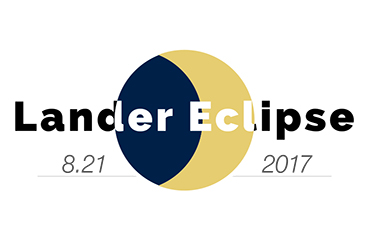 Lander University will be in a prime spot for viewing and recording the next solar eclipse, expected to occur across the continental U.S. on Aug. 21, 2017.
Lander University will be in a prime spot for viewing and recording the next solar eclipse, expected to occur across the continental U.S. on Aug. 21, 2017.
Through a national research experiment known as Citizen CATE - Continental America Telescopic Eclipse - Lander is one of five university sites in South Carolina selected to be an official observation point.
"I think it's a great thing to happen for the Lander community," said Kelly Hughes, technical services manager with Lander's Information Technology Services Department and chair of Lander's Solar Eclipse Planning Committee. "Any of the data we record will be reference material for future students and science professionals."
As part of its selection, Lander will receive a set of observation/photography equipment, valued at around $3,650, to record the eclipse images and keep on a long-term loan.
This equipment includes a solar telescope and a CCD camera - a charge-coupled device, first invented in 1969, which can convert light into electrons and deliver high-quality image data.
Training for all participants in using the equipment and recording the eclipse will be held in April at South Carolina State University, under the direction of Dr. Donald Walter, state coordinator for the Citizen CATE experiment.
After the initial workshop at S.C. State, the Lander team will return to their campus and conduct several practice sessions observing the moon and sun over the next few months.
"Each observing session requires 75 steps and takes two hours to complete," Dr. Walter said. "On the day of the eclipse, every CATE team will record nearly 800 images for future analysis."
Lander participants will have to complete the initial training and be certified before Lander will receive the equipment.
"The images and data will be made publicly available after the project's completion," said Hughes, "and all project contributors will be acknowledged in research papers citing this experiment."
Counting Lander, more than 60 observation sites in the U.S. were selected across the path of the eclipse where totality will take place.
About every two- to two-and-a-half minutes, there will be a handoff between the CATE experiment sites. The images captured will then be tied together into a movie, so that researchers will have an end-to-end record of what the solar corona looked like and how it reacted during the time of the eclipse.
"Opportunities to study the solar corona are rare due to the brightness of the solar surface," Hughes said. "So during this eclipse, solar physicists hope to find some clues about mechanisms that govern unexpected heat differentials measured in the solar corona."
The Citizen CATE experiment was organized by principal investigator Dr. Matt Penn, associate astronomer with the National Solar Observatory in Tucson, Ariz. The purpose of the effort is to give teams of volunteers across the U.S. the opportunity to get involved in research surrounding this rare event.
"The CATE Experiment should unify people from coast to coast," Dr. Penn said. "I hope it will make them aware that they are part of something much bigger than themselves, re-ignite a new wave of citizen science, and inspire students across the U.S. by showing them a path to becoming a scientist."
The time for Lander and Greenwood observers to witness the eclipse will come around 2:39 p.m. and last about 2.5 minutes.
The American Astronomical Society in Washington, D.C. estimates that more than 10 million people are in the 65-mile-wide path of the total eclipse - the first one to cross the U.S. coast-to-coast since June 1918 - and both Walter and Hughes said the experience will be a "once-in-a-lifetime opportunity."
"I've never experienced a total solar eclipse before, and I'm looking forward to the experience," Hughes said, "This experiment is going to give our students, the community and solar physicists a rich data set to work with afterward."